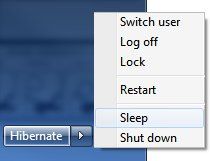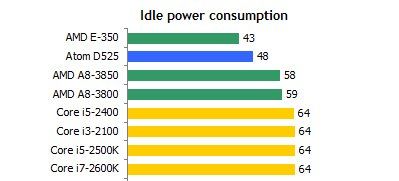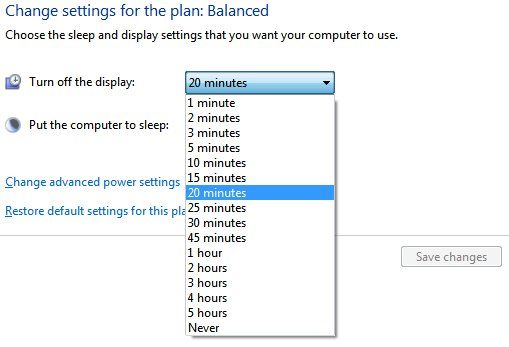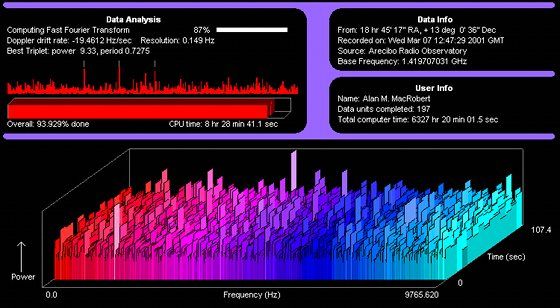Computers, like all electronics, consume a fair amount of electricity. And while the efficiency of the modern computer hardware has improved relative to older parts, there’s still a lot of energy wasted.
Finding ways to save energy with your PC will not only help save the planet. It can also reduce your power bill. But by how much? Let’s have a look at some common energy saving tactics and gauge their impact.
Turning Off Your Computer – Or Putting It To Sleep
A modern computer uses far less energy at idle than it does at load. In fact, stress testing can increase a computer’s power draw by as much as five times as the processors, graphics card and other components attempt to meet the demands of the user.
Still, an idle computer does continue to use energy. How much? Well, according to a recent Tech Report processor review, a modern desktop computer with an Intel Core processor uses 64 watts of power at idle.
Let’s assume that you left your computer on, but at idle, while you slept. Assuming you receive a full eight hours, and that you sleep every night with your computer on, you’ll have used 186,880 watt-hours of energy. Assuming an average price of $12.06, you’re looking at a yearly cost of $22.53.
Obviously, these numbers might vary significantly based on where you live, so try plugging your own figures in this formula.
(Power usage in watts x hours of usage saved) x 365 = Yearly power draw in watt-hours
Yearly power draw / 1000 = Conversion to kilowatt-hours
Kilowatt-hours x Price per kilowatt-hour = Final cost
Keep in mind that this is simply the extra cost of running the computer at idle overnight, which is added to the total energy cost of running your computer. Those who have multiple computers will multiply their savings if this power saving tactic is used.
Adjusting Your Monitor Sleep Settings
Computer monitors are, from the perspective of energy use, nothing more than big light bulbs. In order to form a visible image a light must shine through the LCD panel, and the power used by that light makes up most of a monitor’s overall power draw.
You can save energy and money by aggressively turning off the monitor even if you need your computer to run in the background, a task that can be accomplished using the Windows Power Management settings or the Energy Saver settings of an OS X machine.
Try changing your monitor settings so that the display turns off automatically after three to five minutes. It’s hard to say how much this will save you, because different people have different usage patterns, but let’s say that you frequently go to and from your computer, resulting in a large amount of time where the display is on by not being used – four hours a day sounds like a nice, round figure. We’ll also assume that an average 24-inch monitor is used, which has a power draw of 35 watts.
By adapting the formula above, we find that this scenario saves 51,100 watt-hours of energy per year if power management settings for the monitor are changed, which results in a monetary savings of $6.16 per year.
That’s nothing for a home user, but it can be a more serious issue for a business that owns a hundred monitors or more. It should also be noted that users of less energy efficient monitors, such as large IPS displays and of course CRTs, will reap much larger rewards from aggressive power management because of the higher power draw of such displays. In some cases, these less efficient monitors draw more power than the computers they’re connected to.
Reducing Time At Load
Earlier, it was mentioned that computers use several times more energy at load than they do at idle. Usually, a computer left unattended will be at idle, but that’s not always the case. Leaving a program running can increase power consumption, and there are certain programs – like Bitcoin miners and distributed research software like SETI@home – that are specifically designed to convert idle time into load time.
Let’s go back to the modern Intel Core as a baseline. According to the Tech Report review referenced earlier, a Core i7-2600K will use 144 watts at load. So what happens if your processor is being used when you’re sleeping?
According to the formula, additional power draw per year increases by 420,480 watt-hours, which works out to about $50 per year. Remember, that’s an additional $50 on top of all the other energy costs of running your PC.
The Core i7-2600K represents a relatively good scenario, however. If you instead owned a Phenom X6 1100T processor, for example, your additional cost for running at load while you’re asleep would be about $70 per year, or $20 more than with the Core i7.
Conclusion – Interpreting the Results
As you can see, you’re not likely to go broke by using your computer. The power draw of a modern PC is not insignificant, but it’s not a large percentage of your average household’s power usage. Major appliances like air conditioners, refrigerators and heaters still consume the majority of a home’s power.
With that said, the numbers above do show that you can save money by reducing the energy your computer or computer use. Households with multiple PCs will see the biggest benefit, of course, and businesses are also good candidates for saving money by reducing energy consumption. A small business that asks its employees to turn off their computers before going home could save several thousand dollars a year.






